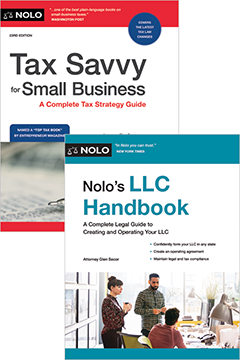Sole proprietors must pay estimated taxes to the IRS periodically. Here's how it works.
If you run a business as a sole proprietorship, you need to make estimated tax payments. You make these payments to the IRS periodically during the course of the calendar year prior to filing your tax return.
Applies to Income Not Subject to Withholding
Estimated tax payments are required for taxable income—such as that from self-employment—which is not subject to withholding. As a sole proprietor, you are self-employed. Therefore, you need to make estimated tax payments that will be applied to your tax liability from self-employment income, as well as to tax on any other taxable income you may have, such as from interest or dividends.
Note: If you are new to being a sole proprietor and are used to working as an employee, estimated taxes may be unfamiliar to you. Employee income is subject to withholding, and employers withhold taxes from each employee paycheck for items like social security and FICA, so estimated taxes generally are not an issue for employees.
Required If You Will Owe at Least $1,000 in Taxes
As a sole proprietor, the government generally requires you to make estimated tax payments if you expect to owe at least $1,000 in taxes for the year. Conversely, if you owed no tax for the previous tax year, you generally do not have to pay estimated taxes during the current tax year.
When Are Payments Due?
For most sole proprietorships, as for most individuals, the tax year is the same as the calendar year. On this basis, the IRS gives you the option either to make a single estimated tax payment for the entire current tax year on the same date your taxes are due for the prior tax year (generally April 15th), or to make four quarterly payments through the course of the current tax year, in mid-April, mid-June, mid-September, and mid-January.
Calculating Payment Amounts and Making Payments
To calculate how much you should pay in estimated taxes, refer to the worksheet included with IRS Form 1040-ES. This worksheet is available at the IRS website at www.irs.gov.
When calculating your estimated taxes, it is often helpful to refer to your tax return for the prior year for information about income, deductions, and credits. As the name indicates, estimated tax payments are estimates; if you find that one of your earlier quarterly payments was too low or too high, you can refer again to the 1040-ES worksheet and refigure your payment for the next quarter.
Remember that, as a sole proprietor, the tax-related information for your business is entered on Schedule C of your personal tax return. The information you enter on Schedule C includes the various income and expenses related to your business, and Schedule C is also where you indicate whether your business made a profit or had a loss. Profit or loss information from Schedule C is then used on Schedule SE, also part of your personal return, to calculate your self-employment tax. There is no separate tax return for sole proprietorships. Therefore, when trying to find prior-year information about your business, you should refer to Schedules C and SE of your last personal tax return.
IRS Form 1040-ES includes quarterly payment vouchers, numbered for payments 1, 2, 3, and 4, with blanks for the amount you're paying and basic personal information such as name, address, and social security number. Each numbered voucher shows when the payment for that quarter is due. Elsewhere on Form 1040-ES is information about where to send your estimated tax payments; the address will vary depending on where you live. Making a payment by mail is as simple as filling in the voucher, writing a check, putting the voucher and check in an envelope, and sending it to the appropriate IRS processing center.
Avoid Penalties
When calculating how much you will pay in estimated taxes, keep in mind that you want to try to be accurate in order to avoid later penalties for underpayment. In general, you will avoid an estimated tax underpayment penalty if you (a) owe less than $1,000 in taxes for the current year; or (b) your estimated tax payments total at least 90% of your total tax liability for the current year or 100% your total tax liability for the prior year, whichever amount is lower.
Also, penalties may be waived in certain exceptional circumstances, such as casualty, disaster, or retirement.
Getting Additional Information
The IRS has additional rules for special situations, such as if you have no income subject to estimated tax during the first part of a calendar year, you work as a farmer or fisherman, or you are a high-income taxpayer. For further information, you should refer to the IRS website.



